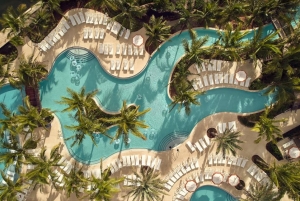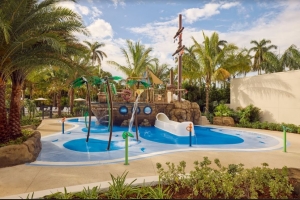By Jeff Sugar
According to a 2022 Trend Report from the online vacation marketplace Vrbo, parents are giving their children a bigger say in travel planning, with 50 percent of families more likely to let their kids decide where to vacation than they were in the era prior to the pandemic.
To adjust to this new paradigm, where the decision-makers span all ages, hotel and resort owners, operators and developers must evaluate their properties through a multi-generational lens – finding the balance between adult-focused amenities and activities that engage children to remain competitive for the short and long term.
A good place for hoteliers to start is by determining their guest profile and fashioning age-appropriate amenities based on what they find. While it may be easy for a resort to focus on guests ages 18 years and older and throw in a “kid’s club”, the current family trend of letting juniors make travel plans demands a more holistic view.
Take the Boca Raton Resort & Club, a historic resort set on 200 acres along Florida’s Gold Coast. Originally designed by architect Addison Mizner in 1926, the resort had been an icon of elegance for decades when current ownership decided a refresh was in order to keep the property competitive and draw in a younger demographic.
While most of the resort’s redesign incorporates contemporary elements and clean, straight lines for a high-class appeal to adult guests, a parcel of the property was reimagined as an immersive experience specifically for kids. The “splash pad” area includes a play structure shaped like a marooned ship; water elements for splashing and spraying; a perimeter of palm trees to shade young guests from the South Florida sun; and details that tie together the resort’s history and ecology with the name of the shipwreck referencing one of Mizner’s famed pet monkeys.
Further north and inland in Kissimmee, Florida, Gaylord Palms Resort & Convention Center has put family entertainment on the front burner with an outdoor Cypress Springs Water Park designed exclusively for younger guests, which features multiple pools, cabanas, a multi-level tree house playground, and pulse-quickening water slides.
When it comes to expanding on the guest experience, too much is never enough. As part of its $158 million expansion, the Gaylord Palms debuted Crystal River Rapids, essentially a “lazy river” for 8- to 13-year-olds that moves along at an exhilarating pace of 3.5 feet per second, taking guests past roaring waterfalls, crumbling limestone walls, sprinkling leaves and more for immersion into the natural wonders of Florida. Rolling fun in the sun and the Sunshine State into one, the attraction has a pull as strong as its current on young decision-makers who help choose family vacation experiences.
The hotelier brand is being similarly creative in Southern California, where Gaylord Pacific Resort Hotel and Convention Center along San Diego Bay in Chula Vista will begin welcoming guests in 2025. The property will have a campus designed with distinctive, full-service areas for every member of the family and more than an acre of water surface. There will be an area for children and adolescents aged three months to three years as well as a setting for all ages with a resort pool, lazy river, and wave pool. There will also be a separate adult pool area for parents to relax by day before heading to social gatherings in the evening.
From a personal, parental and professional perspective, family-travel concepts that have always impressed me include Great Wolf Lodge, which has nearly 20 locations across the United States. The brand goes all out for families and kids, with the Great Wolf Lodge in the Poconos Mountains of Pennsylvania, for example, boasting an indoor water park with features such as a water fort treehouse with interactive water toys, kid-activated splash features, and a tower with body slides. A wave pond with a five-foot deep end and zero-depth entry shallows is a magnet of enjoyment for all ages and abilities. And, an adults-only hot spring is an inviting spot for parents to escape and relax.
Hotel developers that want to attract family travelers should start by determining their target audience and what renovations, enhancements, or additions are possible to expand their guest profile and experiences. In addition, careful examination of the nuances of history, location, culture, and ecology of a site can bring a cohesive narrative and meaningful design intent to the destination. A beachfront hotel in the Caribbean, for instance, may be able to play up the pirate angle so beloved by kids, while a resort in French Polynesia may be able to highlight the history of explorers from Europe.
Of course, not every hotel has the space or budget to go big for the family market. So, go small with subtle features that spur the imagination of kids and draw them into the destination. Something as simple as redesigning entry columns or the pool towel outlet with architectural touches and textures that invoke history or local culture can go a long way toward making young guests feel they’re part of a story – just as a clever cocktail menu lined with locally inspired recipes can make adults feel they’re part of a scene.
Young children need activities, amenities, and programs that spark their curiosity, allow them to be adventurous, and appeal to their sense of wonder. Onsite scavenger and treasure hunts are effective in delighting younger guests. Try putting QR codes at designated spots to relay details of local history or ecology and offer themed trinkets or t-shirts at the hotel gift shop to reward success at the trail’s end. And don’t forget the value of food and beverage outlets. Hoteliers should turn eateries into more than a meal with delineated activities or experiential exhibitions that have an immersive nature.
More than anything, hoteliers must remember vacations are meant to be memory makers and life enhancers – an opportunity to disconnect and reconnect. The most successful destinations cater to and engage the entire family with meaningful vacation options and opportunities for personal connections and transformational experiences.




